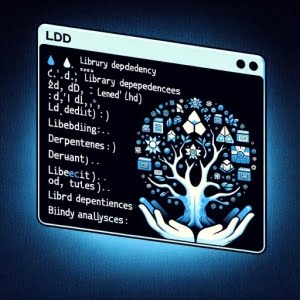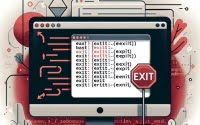ldd Linux Command Guide | Listing Library Dependencies

Ever found yourself curious about the libraries your Linux program is using? You’re not alone. Many developers find themselves intrigued by this hidden information, but there’s a tool that can help you uncover these details.
Like a skilled detective, the ‘ldd’ command in Linux can reveal these hidden details. It can expose the shared libraries your program is using, providing a deeper understanding of your program’s dependencies.
This guide will help you understand and use the ldd command in Linux, from basic usage to advanced techniques. We’ll explore ldd’s core functionality, delve into its advanced features, and even discuss common issues and their solutions.
So, let’s dive in and start mastering the ldd command in Linux!
TL;DR: What is the ldd command in Linux?
The
lddcommand in Linux is a handy tool used to find out the shared libraries required by a program. It is used with the syntax,ldd [arguments] path/to/program. It’s a detective of sorts, revealing the dependencies your program relies on.
Here’s a simple example:
ldd /bin/ls
# Output:
# linux-vdso.so.1 (0x00007ffcc3563000)
# libselinux.so.1 => /lib/x86_64-linux-gnu/libselinux.so.1 (0x00007f24ed8b5000)
# libc.so.6 => /lib/x86_64-linux-gnu/libc.so.6 (0x00007f24ed4c4000)
# libpcre.so.3 => /lib/x86_64-linux-gnu/libpcre.so.3 (0x00007f24ed252000)
# libdl.so.2 => /lib/x86_64-linux-gnu/libdl.so.2 (0x00007f24ed04e000)
# /lib64/ld-linux-x86-64.so.2 (0x00007f24edaf7000)
# libpthread.so.0 => /lib/x86_64-linux-gnu/libpthread.so.0 (0x00007f24ece2f000)
In this example, we’ve used the ldd command on the ‘ls’ command. The output lists all the shared libraries used by the ‘ls’ command, along with their respective memory addresses.
But there’s much more to the ldd command in Linux than just this. Continue reading for more detailed information and advanced usage scenarios.
Table of Contents
- Basic Usage of the Ldd Linux Command
- Exploring Advanced Use of the Ldd Linux Command
- Digging Deeper: Alternative Approaches
- Navigating Common Issues with the Ldd Command
- Understanding Shared Libraries and Dynamic Linking
- The Relevance of the Ldd Command in Software Development
- Wrapping Up: Mastering the Ldd Command in Linux
Basic Usage of the Ldd Linux Command
The ldd command in Linux is a powerful tool that displays the shared libraries required by any given program. It’s a gateway to understanding the dependencies of your Linux program and how they interact.
Let’s take a closer look at how it works with a basic example:
ldd /usr/bin/grep
# Output:
# linux-vdso.so.1 (0x00007ffc8d7dd000)
# libpcre.so.1 => /lib/x86_64-linux-gnu/libpcre.so.1 (0x00007f0725e6b000)
# libc.so.6 => /lib/x86_64-linux-gnu/libc.so.6 (0x00007f0725a7a000)
# libdl.so.2 => /lib/x86_64-linux-gnu/libdl.so.2 (0x00007f0725876000)
# /lib64/ld-linux-x86-64.so.2 (0x00007f07260d3000)
In this example, we’re using the ldd command on the ‘grep’ command. The output lists all the shared libraries used by the ‘grep’ command, along with their respective memory addresses. This can be incredibly useful for understanding the dependencies of your program.
However, it’s important to be aware of potential pitfalls when using the ldd command. One such pitfall is that ldd executes the program it’s inspecting in some cases. This could potentially lead to unexpected behaviors if the program has side effects. Therefore, it’s crucial to only use ldd on trusted programs.
Exploring Advanced Use of the Ldd Linux Command
As you become more comfortable with the basic usage of the ldd command, you can start exploring its more advanced features. These include identifying unused direct dependencies, which can help optimize your program’s performance and efficiency.
Before we delve into these advanced uses, let’s familiarize ourselves with some of the command-line arguments or flags that can modify the behavior of the ldd command. Here’s a table with some of the most commonly used arguments.
| Argument | Description | Example |
| — | — | — |
| -v | Provides detailed information. | ldd -v /usr/bin/grep |
| -u | Shows unused direct dependencies. | ldd -u /usr/bin/grep |
| -r | Shows relocation processing. | ldd -r /usr/bin/grep |
| -d | Shows missing function dependencies. | ldd -d /usr/bin/grep |
| -e | Sets the environment variable. | ldd -e LD_LIBRARY_PATH=/lib /usr/bin/grep |
| -f | Specifies the format. | ldd -f '%p %o |
' /usr/bin/grep
| -n | Avoids displaying the version number. | ldd -n /usr/bin/grep |
| -N | Specifies the version. | ldd -N2 /usr/bin/grep |
| -q | Quiet mode. Only display errors. | ldd -q /usr/bin/grep |
| -h | Displays help. | ldd -h |
Now that we have a basic understanding of these command line arguments, let’s dive deeper into the advanced use of the ldd command.
One of the more complex uses of the ldd command involves identifying unused direct dependencies. This can be achieved using the -u argument. Here’s an example:
ldd -u /usr/bin/grep
# Output:
# Unused direct dependencies:
# /lib/x86_64-linux-gnu/libpcre.so.1
In this example, we’re using the ldd -u command on the ‘grep’ command. The output lists the unused direct dependencies of the ‘grep’ command. This can be incredibly useful for optimizing your program’s performance by identifying unnecessary dependencies.
Digging Deeper: Alternative Approaches
While the ldd command is a powerful tool for uncovering shared library dependencies, it’s not the only tool available. For those looking to expand their toolkit, the objdump command provides an alternative method to find shared libraries.
Using the Objdump Command
The objdump command in Linux is a versatile debugging tool that can display various information about binary files. One of its many uses is to list the shared libraries required by a program.
Let’s see objdump in action:
objdump -p /usr/bin/grep | grep NEEDED
# Output:
# NEEDED libpcre.so.1
# NEEDED libc.so.6
In this example, we’re using the objdump command on the ‘grep’ command, and then filtering the output with grep to only show the lines containing ‘NEEDED’. This output lists the shared libraries needed by the ‘grep’ command, similar to the ldd command.
Comparing Ldd and Objdump
Both ldd and objdump can reveal the shared libraries used by a program, but they do so in slightly different ways. The ldd command actually runs the program with special parameters to find out which libraries are loaded at runtime. On the other hand, objdump just reads the binary file to see which libraries it’s linked against.
This means that ldd can show you more information, such as unused direct dependencies, but it also has potential risks if the program has side effects. Objdump is safer in this regard, but it can’t show unused dependencies.
In conclusion, while the ldd command is a powerful tool for investigating shared libraries, alternative methods like objdump can provide additional insights and safety. Depending on your needs, you might find one tool more useful than the other. As always, the best tool for the job depends on the job at hand.
Like any tool, the ldd command in Linux can occasionally present challenges or issues. One common error that users encounter is the ‘not a dynamic executable’ error. This error typically occurs when you try to use ldd on a script or a statically linked binary.
Understanding the ‘Not a Dynamic Executable’ Error
Let’s look at an example of this error:
ldd /usr/bin/awk
# Output:
# not a dynamic executable
In this case, we’re trying to use the ldd command on the ‘awk’ command. However, ‘awk’ is a script, not a dynamically linked binary, so ldd cannot display any shared libraries.
Overcoming the ‘Not a Dynamic Executable’ Error
If you encounter this error, there are a couple of potential solutions. One approach is to use the file command to determine the type of the file before using ldd:
file /usr/bin/awk
# Output:
# /usr/bin/awk: symbolic link to mawk
The file command reveals that ‘awk’ is a symbolic link to ‘mawk’. Armed with this knowledge, you can then use ldd on ‘mawk’ instead:
ldd /usr/bin/mawk
# Output:
# linux-vdso.so.1 (0x00007fff8d7dd000)
# libc.so.6 => /lib/x86_64-linux-gnu/libc.so.6 (0x00007f0725a7a000)
# /lib64/ld-linux-x86-64.so.2 (0x00007f07260d3000)
Another solution is to use the ldd command with the -r argument, which performs relocation processing and displays any missing function dependencies:
ldd -r /usr/bin/mawk
# Output:
# linux-vdso.so.1 (0x00007fff8d7dd000)
# libc.so.6 => /lib/x86_64-linux-gnu/libc.so.6 (0x00007f0725a7a000)
# /lib64/ld-linux-x86-64.so.2 (0x00007f07260d3000)
By understanding the potential issues and their solutions, you can use the ldd command more effectively and efficiently. Remember, the key is to understand your tools and how to navigate their challenges.
Before we delve deeper into the intricacies of the ldd command, it’s essential to understand the fundamental concepts of shared libraries and dynamic linking in Linux.
Shared Libraries in Linux
Shared libraries are collections of functions and routines that can be used by multiple programs. They are a way to share code and data to make application development easier and more flexible. Shared libraries can be loaded and unloaded at runtime by multiple programs.
Here’s a simple example of a shared library:
ldd /bin/bash
# Output:
# linux-vdso.so.1 (0x00007ffcc3563000)
# libtinfo.so.5 => /lib/x86_64-linux-gnu/libtinfo.so.5 (0x00007f24ed8b5000)
# libdl.so.2 => /lib/x86_64-linux-gnu/libdl.so.2 (0x00007f24ed4c4000)
# libc.so.6 => /lib/x86_64-linux-gnu/libc.so.6 (0x00007f24ed252000)
# /lib64/ld-linux-x86-64.so.2 (0x00007f24edaf7000)
In this example, we’re using the ldd command on the ‘bash’ command. The output lists all the shared libraries used by the ‘bash’ command.
Dynamic Linking in Linux
Dynamic linking is the process where shared libraries are linked to programs at runtime rather than at compile time. This means that the code of the shared library does not need to be included in every program that uses it, saving disk space and memory.
The Role of the Ldd Command
The ldd command fits into this picture by providing a way to view the shared libraries that a program is dynamically linked against. It’s a tool that helps developers understand the dependencies of their programs and optimize their performance.
By understanding shared libraries and dynamic linking, you can gain a deeper understanding of how Linux programs operate and how tools like the ldd command can help optimize your programs.
The Relevance of the Ldd Command in Software Development
The ldd command in Linux is more than just a tool for uncovering shared libraries. It’s a valuable asset in software development, debugging, and system administration. Understanding and mastering the ldd command can enhance your ability to optimize programs, troubleshoot issues, and manage systems effectively.
Exploring Related Concepts
Beyond the ldd command, you may also want to explore related concepts like static and dynamic linking, dynamic loaders, and more. These concepts provide a broader context for understanding the ldd command and its role in Linux systems.
Static and dynamic linking are two methods of linking a program with its dependencies. While static linking includes all the dependencies in the final executable, dynamic linking loads the dependencies at runtime. Understanding these concepts can help you make informed decisions when developing and optimizing your programs.
Dynamic loaders, on the other hand, are the part of the system that loads and manages shared libraries. They play a crucial role in dynamic linking and are a fundamental part of how Linux systems operate.
Further Resources for Mastering the Ldd Command
To deepen your understanding of the ldd command and related concepts, consider exploring the following resources:
- Linux Programmer’s Manual: This manual provides detailed information about various Linux commands, including
ldd. Advanced Linux Programming: This book covers a wide range of topics, including shared libraries and dynamic linking.
GNU C Library Documentation: This documentation provides in-depth information about the GNU C Library, which is the core library in most Linux distributions.
Wrapping Up: Mastering the Ldd Command in Linux
In this comprehensive guide, we’ve journeyed through the world of the ldd command in Linux, a powerful tool for uncovering shared libraries used by a program.
We began with the basics, learning how to use the ldd command in a simple and straightforward manner. We then ventured into more advanced territory, exploring complex uses of the ldd command, such as identifying unused direct dependencies and using various command-line arguments for more detailed results.
Along the way, we tackled common challenges you might face when using the ldd command, such as the ‘not a dynamic executable’ error, providing you with solutions and workarounds for each issue.
We also looked at alternative approaches to finding shared libraries, comparing the ldd command with the objdump command. Here’s a quick comparison of these methods:
| Method | Pros | Cons |
|---|---|---|
| Ldd | Detailed information, identifies unused dependencies | Can execute program, potential side effects |
| Objdump | Safer, does not execute program | Cannot identify unused dependencies |
Whether you’re just starting out with the ldd command or you’re looking to level up your Linux skills, we hope this guide has given you a deeper understanding of the ldd command and its capabilities.
With its ability to reveal hidden dependencies, the ldd command is a powerful tool for software development, debugging, and system administration. Happy coding!

